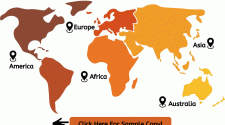A game of one-upmanship has been unfolding among Canada’s telecom giants as they seek to score 5G market dominance.
After an initially tempered rollout – at least by international standards – of the next-generation wireless infrastructure, the country’s top three providers have been unfurling a flurry of network expansion announcements since the summer.
Early last year, Rogers Communications Inc. (TSX:RCI.B) became the first wireless carrier to deploy 5G in Vancouver. It doubled-down again in December, revealing it was rolling out its first 5G standalone core – effectively the brains of the network – in the city.
Previous 5G offerings from Rogers, Bell Canada [BCE Inc. (TSX:BCE)] and Vancouver-based Telus Corp. (TSX:T) had all been built on top of existing LTE infrastructure, while the standalone core is independent from that and will be used to support future devices as they become available.
Meanwhile, Telus, Rogers and Bell have been gradually expanding 5G coverage outside Vancouver’s downtown core and into some of the suburbs and smaller communities throughout the province.
In comparison, South Korea, which is just over three times the size of Vancouver Island, has deployed 5G coverage to 90% of its 52 million residents, according to June 2020 estimates from research company OMDIA.
Stephen Wiktorski, the head of networks for Samsung Canada, said countries like South Korea have benefited from their head starts in deploying the ultra-fast 5G networks years ahead of Canada.
“I don’t think it’ll take the Canadian operators like Telus very long to catch up on the gap that there might be today,” he said in a phone call from Toronto. “It’s only a matter of time and I think the gap will close very quickly, and I think you’ll see operators like Telus bubble to the top of the world’s fastest networks and most advanced 5G networks.”
Samsung has been courting Canadian wireless providers amid espionage concerns surrounding equipment from Chinese tech giant Huawei Technologies Co. Ltd.
Some of Canada’s closest intelligence allies have banned the use of Huawei equipment in their country’s 5G networks, while Ottawa has yet to make a decision on whether to permit the equipment’s use in Canada.
Telus had long been aligned with Huawei on its 5G ambitions, but Telus and Bell eventually left the Chinese company in the dust last June when they announced they were tapping European vendors Telefonaktiebolaget LM Ericsson (Nasdaq:ERIC) and Nokia Corp. (HEL:NOKIA) to build out their 5G networks.
Telus has since confirmed it’s also tapping Samsung Electronics Co. Ltd. to help deploy its 5G products.
While many Canadians might associate the technology with faster speeds on their 5G-compatible smartphones, Wiktorski said the impact will reach far beyond that.
Virtual consultations with medical professionals far away could become the norm, as will the ability of surgeons in other countries to mentor colleagues in operating rooms without even one second of delay in the video feed.
Wiktorski said 5G deployment is also poised to accelerate the adoption of wearable technologies, driverless vehicles and “smart cities,” in which urban areas are equipped with sensors to collect and analyze data in real time.
The University of British Columbia (UBC) and Rogers Communications Inc. (TSX:RCI.B) began deploying 5G-powered sensors at intersections in downtown Kelowna in 2020.
The LIDaR (light detection and ranging) sensors can collect more intricate data than conventional traffic cameras, such as tapping into facial recognition or logging identifying details of passersby.
“This technology allows you to make real-time decisions and be more adaptive, rather than just things that are programmed like a clock,” UBC Prof. David Michelson, the project’s lead researcher, told BIV last year.
He said applications could include using sensors to recognize that a pedestrian is elderly and might require more time to cross a crosswalk. Traffic lights would also be able to detect the approach of emergency vehicles and adjust settings to clear a path.
The development of 5G infrastructure in Canada means Internet of Things sensors, smart watches, driverless cars – anything with a wireless component – will be able to interact with minimal latency.
“When they developed 5G, they were very clear they wanted to bring these non-handset applications into the mainstream,” Michelson said. “This is the sort of project that no single player could have done by itself.” •













